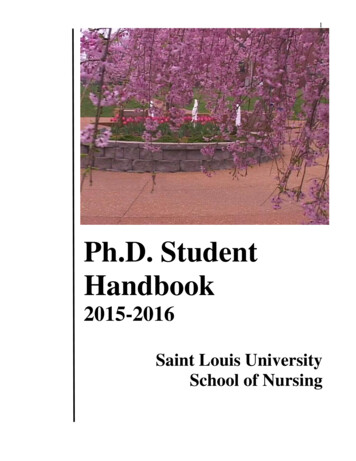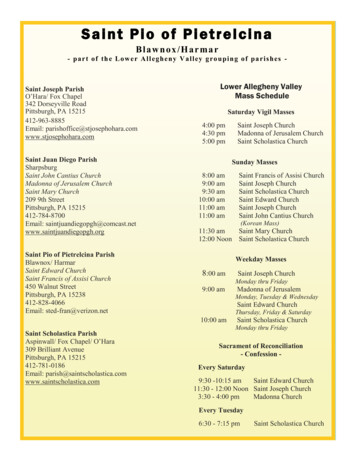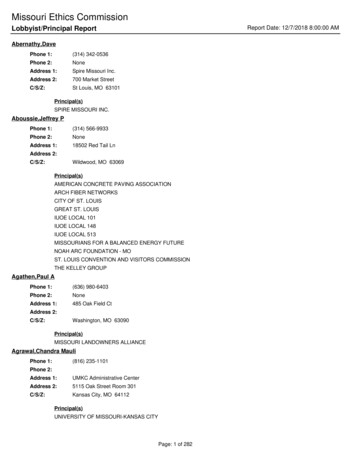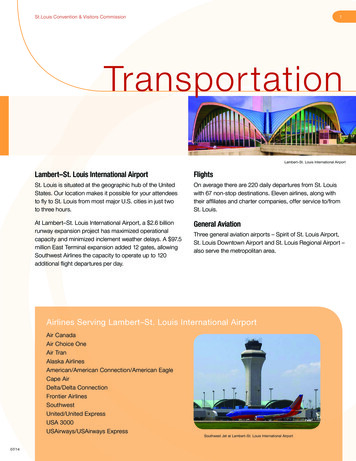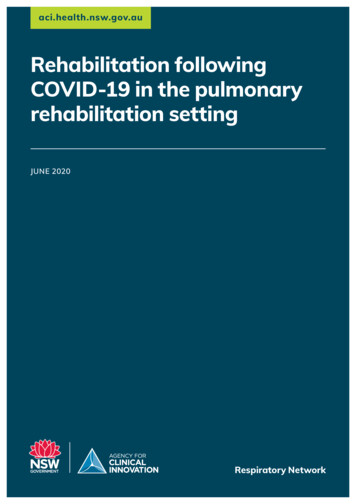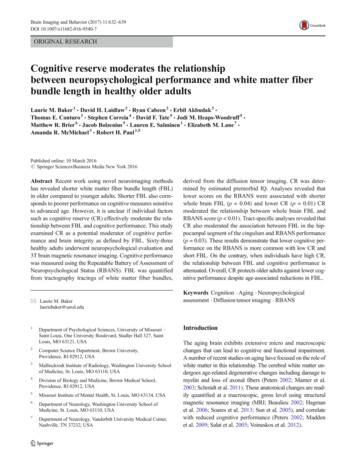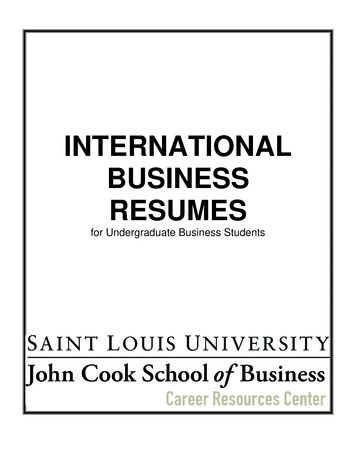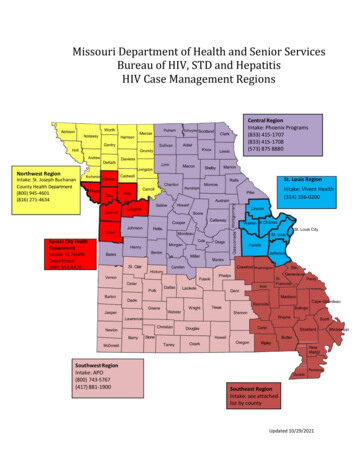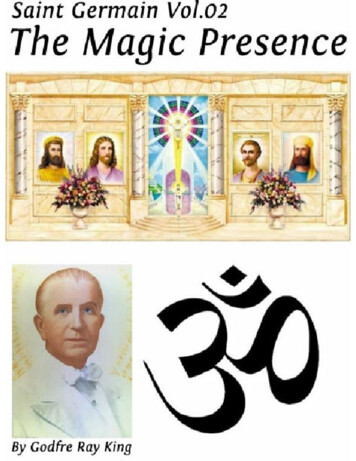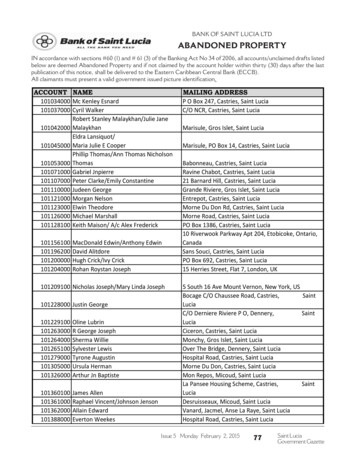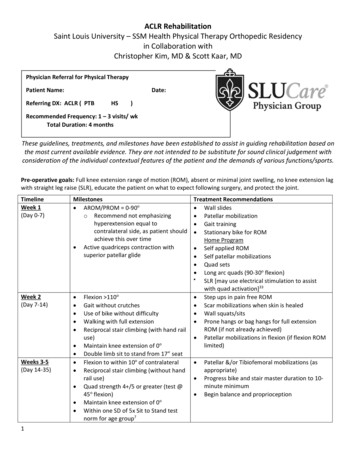
Transcription
ACLR RehabilitationSaint Louis University – SSM Health Physical Therapy Orthopedic Residencyin Collaboration withChristopher Kim, MD & Scott Kaar, MDPhysician Referral for Physical TherapyPatient Name:Date:Referring DX: ACLR ( PTBHS)Recommended Frequency: 1 – 3 visits/ wkTotal Duration: 4 monthsThese guidelines, treatments, and milestones have been established to assist in guiding rehabilitation based onthe most current available evidence. They are not intended to be substitute for sound clinical judgement withconsideration of the individual contextual features of the patient and the demands of various functions/sports.Pre-operative goals: Full knee extension range of motion (ROM), absent or minimal joint swelling, no knee extension lagwith straight leg raise (SLR), educate the patient on what to expect following surgery, and protect the joint.TimelineWeek 1(Day 0-7)Milestones AROM/PROM 0-90oo Recommend not emphasizinghyperextension equal tocontralateral side, as patient shouldachieve this over time Active quadriceps contraction withsuperior patellar glideWeek 2(Day 7-14) Weeks 3-5(Day 14-35) 1Flexion 110oGait without crutchesUse of bike without difficultyWalking with full extensionReciprocal stair climbing (with hand railuse)Maintain knee extension of 0oDouble limb sit to stand from 17” seatFlexion to within 10o of contralateralReciprocal stair climbing (without handrail use)Quad strength 4 /5 or greater (test @45o flexion)Maintain knee extension of 0oWithin one SD of 5x Sit to Stand testnorm for age group7Treatment Recommendations Wall slides Patellar mobilization Gait training Stationary bike for ROMHome Program Self applied ROM Self patellar mobilizations Quad sets Long arc quads (90-30o flexion) SLR [may use electrical stimulation to assistwith quad activation]33 Step ups in pain free ROM Scar mobilizations when skin is healed Wall squats/sits Prone hangs or bag hangs for full extensionROM (if not already achieved) Patellar mobilizations in flexion (if flexion ROMlimited) Patellar &/or Tibiofemoral mobilizations (asappropriate)Progress bike and stair master duration to 10minute minimumBegin balance and proprioception
ACLR Rehabilitation Weeks 6-8(Day 35-56) Weeks 9-12(Day 56-84) Weeks 13Return to Sport Follow upfunctionaltestingNormalized gait patternFull ROM compared to contralateral(recommend not emphasizinghyperextension)No greater than 1 effusion using theStroke test355x Sit to stand: normal values for agegroup7 2 errors on SL squat3,15Hop tests 85%Maintain ROMTrace to Zero effusion grade using thestroke test 1 errors on SL squat (week 10)3,15Zero errors on SL squat (week 12)3,15 Progressive resistive exercisesBegin running progression on treadmill(progression based on the Soreness Rules)10 Sport specific exercisesAgility activitiesFunctional testingClosed chain core strengtheningRunning progressionAll hop tests symmetry 90%11Modified Star Excursion Balance Testsymmetry 4cm14Acute to chronic workload ratio 1.513,16,174, 5, 6, and 12-month post-op testingProgression towards power activities asneeded Sport specific exercisesAgility activitiesFunctional testingClosed chain core strengtheningRunning progressionMaintain gains in strengthHop tests (90-100% of contralateral)Maintain ROMPrecautions/Additional informationGraft protection: Brace use and graft type are at the discretion of the surgeon.Stress to ACL with passive ROM 0-120o is minimal. Most strain occurs in last 30o of NWB extension2,5,9,15.Adjunct treatments: NMES may be instrumental in improving muscular performance for those not responding to traditionalstrengthening33.If concomitant injury present at the same time, that injury dictates rehab progression:o meniscal injury with repair: Full PROM is allowed. Ambulate WBAT with brace locked at 0 until week 5 No loaded knee flexion beyond 45 until week 5, none beyond 90 until week 8 No forced knee hyperextension if anterior horn repair /No forced knee flexion if posterior hornrepair Avoid OKC exercise from 0-30 and CKC exercise from 90-120 if patient shows signs/symptomsof patellofemoral irritation4,5oochondral damage: restrict WB for 3-4 weeks to avoid stressing the healing cartilage. Beware thatprolonged weight bearing restriction may result in difficulty recovering ROM and quad activation20.partial meniscectomy: no modification of guideline (symptom management)12.2Updated 2017-10-03
ACLR RehabilitationooMCL: If surgical repair, avoid directly stressing the MCL, and consider sagittal plane limitations ifneeded24,31.PCL: follow PCL guidelinesTreatment Progression/Success: Factors that can impact rehabilitation success include the following: psychosocial issues, motivation, swelling,quad activation failure, acute reconstruction21, involvement of other structures22. Success measured by: 1. Less than mild effusion, 2. 90% hamstring and 3. quad strength, 4. Absence of givingway episodes, 5. Participation in 1-2 seasons of sports at previous activity level, 6. Patient reported outcomes20. Patient Reported Outcome Measure: Consider using SANE score, as it correlates well with Cincinnati Knee RatingSystem29. Consider using Stoke Test Grading for Effusion to determine whether to progress35. Use this tool to assist withgrading activity. I.e. - increased effusion by 2 grades would lead to a decrease in activity until the effusiondecreases to the previous level. Weight bearing exercises alone are not enough for optimal outcomes. Graded increases in load, appropriate tothe phase of healing, should be considered. 33For questions regarding the patient’s medical care, neworders, or insurance questions:For additional questions, comments, or concernsregarding the implementation of these physical therapyguidelines, please contactDr. Kaar's patients should contact Duncan at 314-5778525 or duncan.mchardy@health.slu.edu.Chris Sebelski, PT, DPT, PhD, OCS, Director of the SLU –SSM Health Physical Therapy Residency 314 977 8724 ORchris.sebelski@health.slu.eduDr. Kim's patients should contact Julia (clinical nursespecialist) at 314-577-8524 orjulia.santiago@health.slu.edu.Please respond to our anonymous survey regarding these guidelines to assist in improving patient care and advocacy.https://slu.az1.qualtrics.com/jfe/form/SV bpX7Z9AaVTzGbljAppendices of referenced assessmentsSoreness Rules Adapted from Fees et al. 199810CriterionAction1. Soreness during warm-up that continues2. Soreness during warm-up that goes away3. Soreness during warm-up that goes away from redevelopsduring session4. Soreness the day after lifting (not muscle soreness)5. No soreness2 days off, drop down 1 stepStay at step that led to soreness2 days off, drop down 1 step1 day off, do not advance program to the next stepAdvance 1 step per week or as instructed by healthcareprofessional3Updated 2017-10-03
ACLR Rehabilitation 5xSTS Normative Values7Age (n)Mean SD (95%CI)Min-Max14–19 (25)6.5 1.2 (6.0–7.04.7-9.720-29 (36)6.0 1.4 (5.6–6.5)3.9–11.230–39 (22)6.1 1.4 (5.5–6.8)4.1–10.440–49 (15)7.6 1.8 (6.6–8.6)5.6–13.250–59 (20)7.7 2.6 (6.5–8.9)4.2–12.160–69 (25)7.8 2.4 (6.8–8.7)4.7–15.170–79 (24)9.3 2.1 (8.4–10.1)5.5–13.380–85 (14)10.8 2.6 (9.3–12.3)5.8–17.6Errors (Impairments) seen in Single Leg Squat Movement Adapted from (Liebenson 2002)18 in (Bailey et al 2010)3Midfoot collapseEarly heel risePoor control of knee with ascentFemoral adduction, IRPelvic dropExcessive trunk flexion or knee extension on ascentRunning Program1:LevelTreadmillTrack10.1-mile walk/0.1-mile jog, repeat 10 timesJog straights/walk curves (2 miles)2Alternate 0.1-mile walk/0.2-mile jog (2 miles)Jog straights/jog 1 curve every other lap (2 miles)3Alternate 0.1-mi walk/0.3-mi jog (2 miles)Jog straights/jog 1 curve every lap (2 miles)4Alternate 0.1-mi walk/0.4-mi jog (2 miles)Jog 1.75 laps/walk curve (2 miles)5Jog full 2 milesJog all laps (2 miles)6Increase workout to 2.5 milesIncrease workout to 2.5 miles7Increase workout to 3 milesIncrease workout to 3 miles8Alternate between running/jogging every 0.25 milesIncrease speed on straights/jog curves Hop tests1:Return to sport dosing should consider Acute-to-chronic workload13, 16-17Each session calculated by multiplying RPE (0-10) byduration (minutes) to obtain workload (augmented units).For example, RPE of 6 x 60 minutes workload of 360 AUs.Acute workload average workload over the course of 1weekChronic workload average workload over course of 4weeks4Updated 2017-10-03
ACLR 16.17.18.19.20.Adams D, Logerstedt DS, Hunter-Giordano A, Axe MJ, SnyderMackler L. Current concepts for anterior cruciate ligamentreconstruction: a criterion-based rehabilitation progression. JOrthop Sports Phys Ther. 2012;42(7):601-14.Arms SW, Pope MH, Johnson RJ, Fischer RA, Arvidsson I,Eriksson E. The biomechanics of anterior cruciate ligamentrehabilitation and reconstruction. Am J Sports Med.1984;12(1):8-18.Bailey R, Selfe, J, Richards J. The single leg squat test in theassessment of musculoskeletal function: a review. PhysiotherIreland. 2010;13(1):18-23.Barber FA, Click SD. Meniscus repair rehabilitation withconcurrent anterior cruciate reconstruction. Arthroscopy.1997;13(4):433-7.Beynnon BD, Johnson RJ, Fleming BC, Stankewich CJ,Renström PA, Nichols CE. The strain behavior of the anteriorcruciate ligament during squatting and active flexionextension. A comparison of an open and a closed kineticchain exercise. Am J Sports Med. 1997;25(6):823-9.Bohannon RW. Knee extension strength and body weightdetermine sit-to-stand independence after stroke.Physiotherapy theory and practice. 2007; 23(5):291-7.Bohannon RW, Bubela DJ, Magasi SR, Wang YC, Gershon RC.Sit-to-stand test: Performance and determinants across theage-span. Isokinetics and exercise science. 2010; 18(4):235240.Chen FS, Rokito AS, Pitman MI. Acute and chronicposteroloateral rotatory instability of the knee. J Am AcadOrthop Surg. 2000; 8:97-110.Chester R, Smith TO, Sweeting D, Dixon J, Wood S, Song F.The relative timing of VMO and VL in the aetiology of anteriorknee pain: a systematic review and meta-analysis. BMCMusculoskelet Disord. 2008;9:64.Fees M, Decker T, Snyder-Mackler L, Axe MJ. Upper extremityweight-training modifications for the injured athlete. Aclinical perspective. Am J Sports Med. 1998;26:732-742.Fitzgerald GK, Lephart SM, Hwang JH, Wainner RS. Hop testsas predictors of dynamic knee stability. J Orthop Sports PhysTher. 2001;31:588-597.Fitzgibbons RE, Shelbourne KD. "Aggressive" nontreatment oflateral meniscal tears seen during anterior cruciate ligamentreconstruction. Am J Sports Med. 1995;23(2):156-9.Gabbett TJ, Kennelly S, Sheehan J, et al. If overuse injury is a‘training load error’, should undertraining be view the sameway? Br J Sports Med. 2016;50:1017-1018.Garrison J, Bothwell J, Wolf G, et al. Y balance test anteriorreach symmetry at three months is related to single legfunctional performance at time of return to sports followinganterior cruciate ligament reconstruction. Int J Sports PhysTher. 2015;(10)5:602-611.Henning CE, Lynch MA, Glick KR. An in vivo strain gage studyof elongation of the anterior cruciate ligament. Am J SportsMed. 1985;13(1):22-6.Hulin BT, Gabbett TJ, Blanch P, et al. Spikes in acute workloadare associated with increased injury risk in elite cricket fastbowlers. Br J Sports Med. 2014;48:708-712.Hulin BT, Gabbett TJ, Caputi P, et al. Low chronic workloadand the acute:chronic workload ratio are more predictive ofinjury than between-match recovery time: a two-seasonprospective cohort study in elite rugby league players. Br JSports Med. 2016;50:1008–12.Liebenson C. Functional exercises. J Bodywork and MovemTher. 2002;6(2):108-13Lindenfeld TN, Hewett TE, Andriacchi TP. Decrease in kneejoint loading with unloader brace wear in patient with medialcompartment gonarthrosis [abstract]. Proc Annual MeetingAmerican Academy of Orthopaedic Surgeons. 1996:243Lynch AD, Logerstedt DS, Grindem H, et al. Consensus criteriafor defining 'successful outcome' after ACL injury .reconstruction: a Delaware-Oslo ACL cohort investigation. Br JSports Med. 2015;49(5):335-42.Majors RA, Woodfin B. Achieving full range of motion afteranterior cruciate ligament reconstruction. Am J Sports Med.1996;24(3):350-5.Meszler D, Manal TJ, Snyder-Mackler L. Disorders of thetibiofemoral joint. Orthop Clin North Am. 1998;7:347-366.Millett PJ, Pennock AT, Sterett WI, Steadman JR. Early ACLreconstruction in combined ACL-MCL injuries. J Knee Surg.2004;17(2):94-8.Noyes FR, Barber-westin SD. The treatment of acutecombined ruptures of the anterior cruciate and medialligaments of the knee. Am J Sports Med. 1995;23(4):380-9.Palmitier RA, An KN, Scott SG, Chao EY. Kinetic chain exercisein knee rehabilitation. Sports Med. 1991;11(6):402-13Parker MG. Biomechanical and histological concepts in therehabilitation of patients with anterior cruciate ligamentreconstructions. J Orthop Sports Phys Ther. 1994;20(1):44-50.Reinold MM, Wilk KE, Macrina LC, Dugas JR, Cain EL. Currentconcepts in the rehabilitation following articular cartilagerepair procedures in the knee. J Orthop Sports Phys Ther.2006;36(10):774-94.Rubinstein RA, Shelbourne KD, Vanmeter CD, Mccarroll JR,Rettig AC, Gloyeske RL. Effect on knee stability if fullhyperextension is restored immediately after autogenousbone-patellar tendon-bone anterior cruciate ligamentreconstruction. Am J Sports Med. 1995;23(3):365-8.Rudolph KS, Eastlack ME, Axe MJ, Snyder-mackler L. 1998Basmajian Student Award Paper: Movement patterns afteranterior cruciate ligament injury: a comparison of patientswho compensate well for the injury and those who requireoperative stabilization. J Electromyogr Kinesiol.1998;8(6):349-62.1Sailors ME, Keskula DR, Perrin DH. Effect of running onanterior knee laxity in collegiate-level female athletes afteranterior cruciate ligament reconstruction. J Orthop SportsPhys Ther. 1995;21(4):233-9.Schierl M, Petermann J, Trus P, Baumgärtel F, Gotzen L.Anterior cruciate and medial collateral ligament injury. ACLreconstruction and functional treatment of the MCL. KneeSurg Sports Traumatol Arthrosc. 1994;2(4):203-6.Shelbourne, K., Barnes, A., & Gray, T. (2012). Correlation of aSingle Assessment Numeric Evaluation (SANE) Rating WithModified Cincinnati Knee Rating System and IKDC SubjectiveTotal Scores for Patients After ACL Reconstruction or KneeArthroscopy. The American Journal Of Sports Medicine,40(11), 2487-2491.Snyder-mackler L, Delitto A, Stralka SW, Bailey SL. Use ofelectrical stimulation to enhance recovery of quadricepsfemoris muscle force production in patients followinganterior cruciate ligament reconstruction. Phys Ther.1994;74(10):901-7.Snyder-mackler L, Delitto A, Bailey SL, Stralka SW. Strength ofthe quadriceps femoris muscle and functional recovery afterreconstruction of the anterior cruciate ligament. Aprospective, randomized clinical trial of electrical stimulation.J Bone Joint Surg Am. 1995;77(8):1166-73. 2Sturgill, L., Snyder-Mackler, L., Manal, T., & Axe, M. (2009).Interrater Reliability of a Clinical Scale to Assess Knee JointEffusion. Journal of Orthopaedic & Sports Physical Therapy,39(12), 845-849.Wilk KE. Rehabilitation of isolated and combined posteriorcruciate ligament injuries. Clin Sports Med. 1994; 13:649-6775Updated 2017-10-03
1. Adams D, Logerstedt DS, Hunter-Giordano A, Axe MJ, Snyder-Mackler L. Current concepts for anterior cruciate ligament reconstruction: a criterion-based rehabilitation progression. J Orthop Sports Phys Ther. 2012;42(7):601-14. 2. Arms SW, Pope MH, Johnson RJ, Fischer RA, Arvidsson I, Eriksson E. The biomechanics of anterior cruciate ligament
